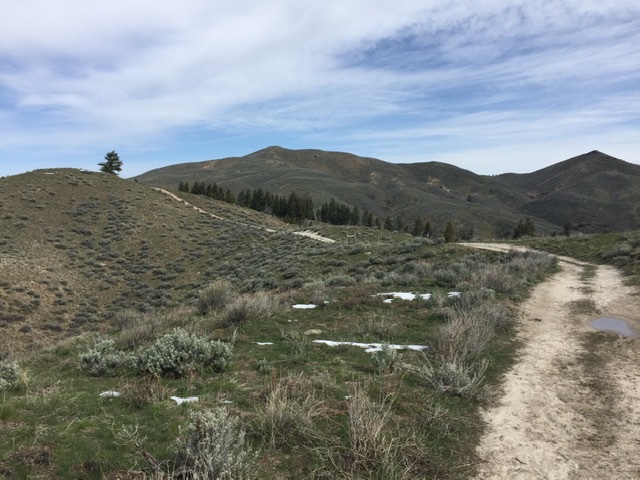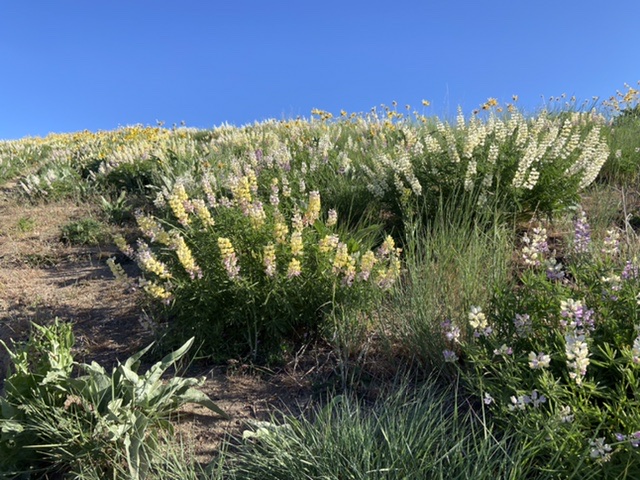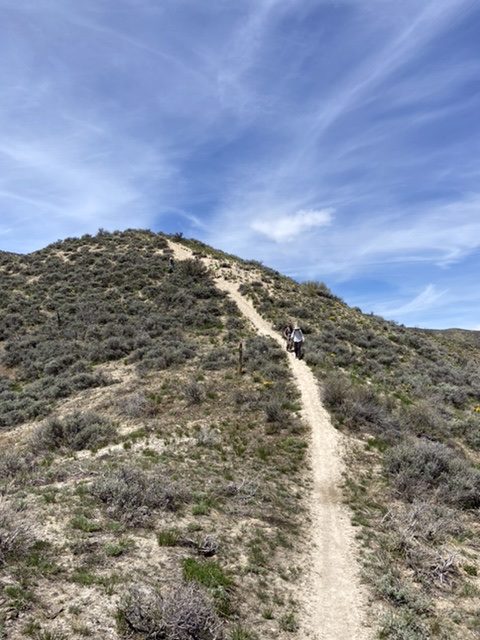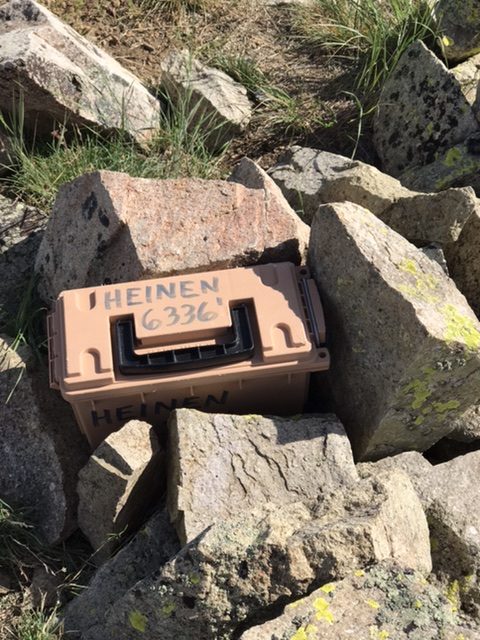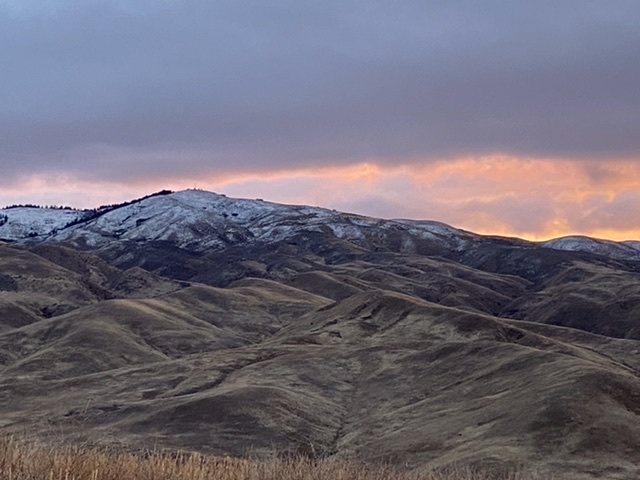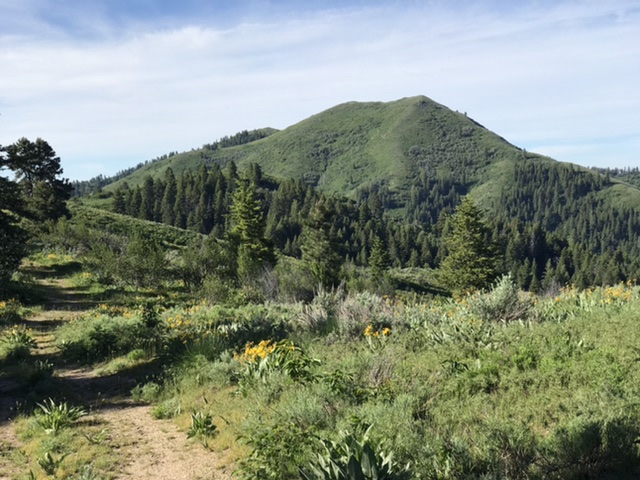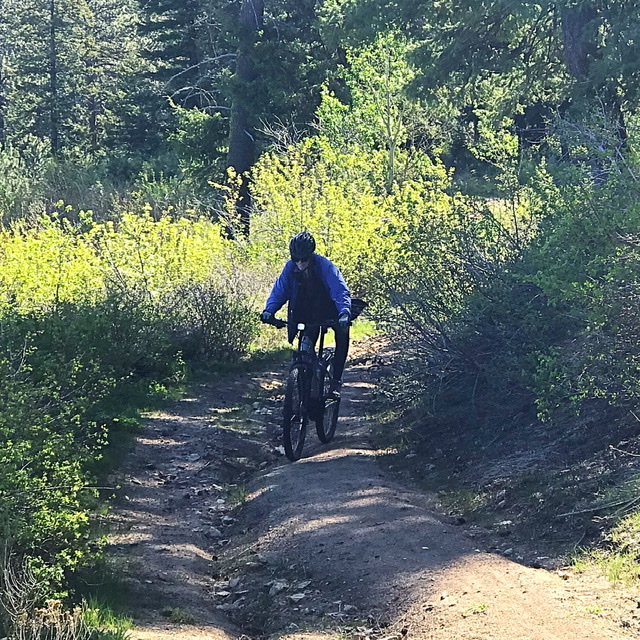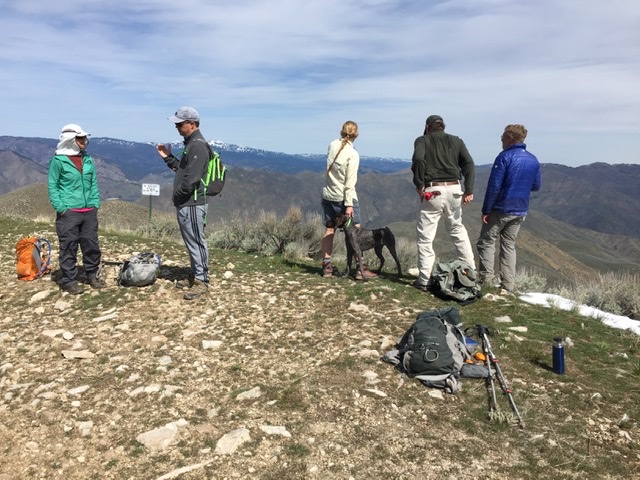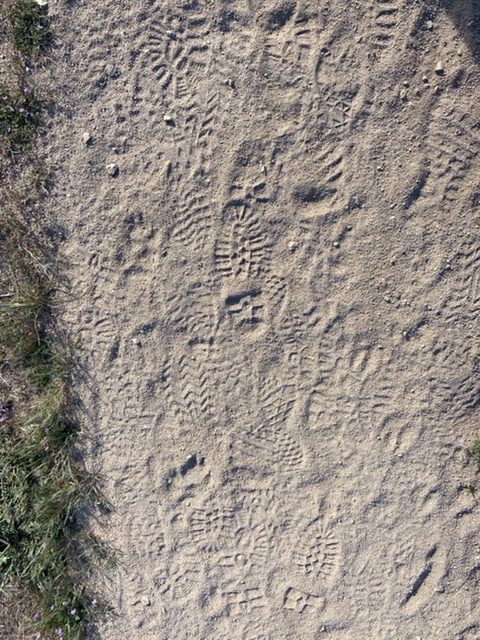Article Index
This article originally appeared in the Idaho Magazine’s September 2021 issue. VOL. 20, NO. 12
Spring Training in the Mountains
Story and Photos by Tom Lopez
 “I’m going for the Grand Slam,” exclaimed the muscular young hiker as he passed me, nearly running up the steep trail that leads to the top of Cervidae Peak.
“I’m going for the Grand Slam,” exclaimed the muscular young hiker as he passed me, nearly running up the steep trail that leads to the top of Cervidae Peak.
“Good luck,” I shouted.
As he hurriedly pulled away from me his last words were, “Know anything about the Slam?”
He was already too far away for me to yell back but, I thought, “Yes, I do.”
The Grand Slam Peaks are Cervidae, Kepros Mountain, Shaw Mountain/Lucky Peak, and Mount Heinen. All four peaks are short drives from my home in Boise. Since the late-1980s, I have used these peaks to get in shape for the summer climbing season. They’re far from Idaho’s most impressive mountains, yet each peak is challenging. Their different physical make-ups give each a distinctive personality.
At first, these peaks attracted me only as easily-accessible training locations. Idaho has nearly 5,000 ranked peaks scattered across its 88,633 square miles. I know that I will never visit them all but I hope to visit as many as possible. So why re-climb a peak when there are many more for me to discover? After all, a climber’s journey often embraces sustained suffering to reach the final reward. That’s why many climbers are repelled if someone suggests they climb a peak a second time, let alone many times. But for me, climbing is a personal journey of exploration of both the mountains and myself. I believe if I’m attentive, I can learn something new about the world and myself with each repetition. These four peaks may have originally represented a training exercise of toil and suffering but, over time, the experience changed into a joyful reunification with old friends.
In the early days, I often invited friends along on these climbs but we seldom ran into other hikers. Occasionally, I would cut brush and mark the most efficient route with cairns but, generally, the peaks felt like my private Idaho. Nowadays, these four peaks are extremely popular and to not encounter other hikers on them is the exception rather than the rule.
The peaks are in my guidebook, Idaho: A Climbing Guide, and years ago I added a page to my website to cover what I called the Grand Slam Peaks. This name came easily to me. I started playing baseball at age eight in 1959 and was a baseball fanatic before mountain climbing became my obsession. As dreary Michigan winters dragged on toward Spring, the light at the end of the tunnel was the start of professional’s baseball Spring training—a time when we hoped and prayed that the Detroit Tigers would find a way to slay the hated New York Yankees. When the professional teams started to unlimber in Florida, we knew the weather would soon turn and we would be out on the baseball diamond doing what we loved. Every kid’s dream was to hit a home run with the bases loaded so it later seemed natural to me that a nickname for “Spring training” on four peaks should be the “Grand Slam.”
Seven years ago, when I revamped my website, the Grand Slam Peak page was lost in transition. I soon received an email that asked what had happened to the page and requested I “add it back.” This was the first time that I realized these four peaks were of interest to others. I restored the page and before long started to see references to the Grand Slam Peaks on other websites. Those pages on my website are among the most visited, ranking only behind Borah Peak and “Idaho 12er” pages that describe the nine peaks in Idaho taller than twelve thousand feet. The trails leading to the Grand Slam Peaks are now well-beaten paths and each year the register notebooks in containers on the summits quickly fill up.
One of the four peaks, Cervidae, is located just northwest of the Spring Shores Marina on Lucky Peak Reservoir. The lowest one in elevation, it often is snow-free by mid-February. It has a classic pyramidal mountain shape with a series of steep ridges that climbers can ascend to its summit. In many ways it resembles a miniature Mount Borah. The peak’s name originated with Dan Robbins and, thanks to his efforts, it was adopted in 2015 by the U.S. Board of Geographic Names.
In scientific taxonomy, Cervidae is the name for the deer family, and many mule deer are found on this peak year-round. I have climbed the mountain from four directions. The most popular route, which starts near the Springs Shore Marina, is 2.1 miles to the top with an elevation gain of just under two thousand feet. So many people use this route that their feet have worn a trail into the mountain’s flanks from start to finish. While there are no official figures, I suspect that Cervidae sees far more ascents each year than Mount Borah.
Kepros Mountain, northeast of the Lucky Peak Dam, is at the north end of a long ridge line that begins on Three Point Mountain at the edge of the Snake River Plain and runs north to Arrowrock Dam. Kepros involves a classic ridge walk with plenty of ups and downs. Conquering this peak is just half the battle because the return trip involves nearly as much uphill work as the ascent. A two-track road (that’s open only during hunting season) and segments of trail that I marked over the years lead all the way to the top. Round-trip, this ramble covers ten miles of constant up-and-down scenic walking. The views are sweeping and include the other three Grand Slam Peaks as well as Shafer Butte, Steele Mountain, Trinity Mountain, Danskin Peak, the Owyhee Mountains, and Lucky Peak and Arrowrock reservoirs. Kepros was named after George Kepros who homesteaded and ran sheep across this area many years ago.
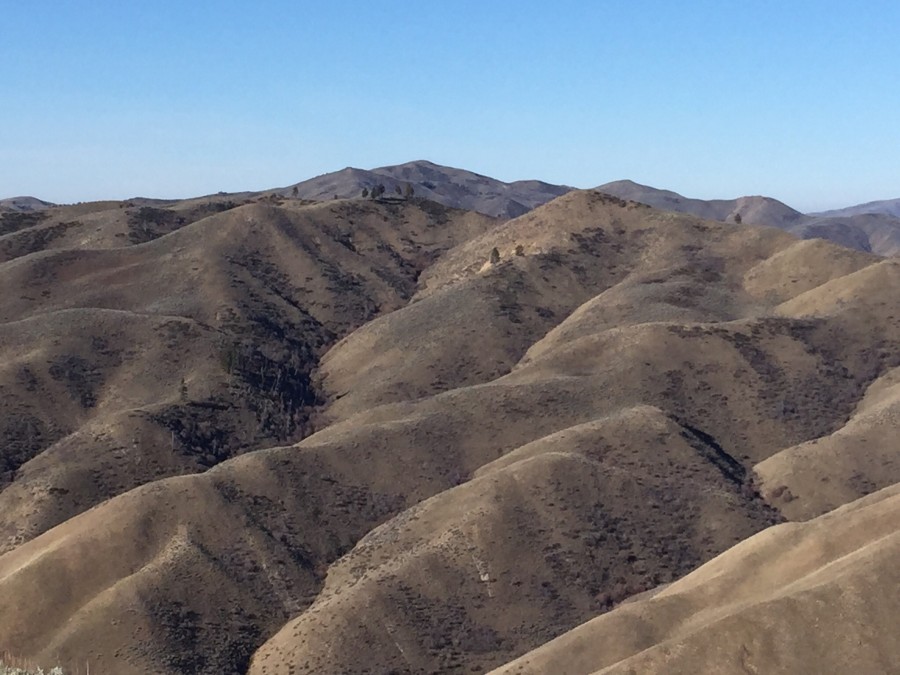
Kepros Peak as viewed from Peak 5180. The Danskins cover a large swath of Idaho but are little known to most. As this view demonstrates, the range has lots of ridges to wander across.
Shaw Mountain is the big, attractive mountain that looms behind Table Rock and its iconic cross to form a backdrop to eastern Boise. It has several high points, the tallest of which is Lucky Peak. Unlike the sagebrush-covered slopes of Cervidea and Kepros, this peak’s terrain transitions from sagebrush and desert flora in the Barber Valley to healthy pine and fir forests on its upper slopes. It is the most accessible of the four mountains with four routes to the top. During Summer and Fall, you can drive nearly to the summit in a good 4WD vehicle if you have the appropriate skills. There is no better place to view Boise than from this peak.
Idaho Fish and Game manages the land surrounding Shaw Mountain and makes wildlife management its number one priority. Boise State University uses the peak as a bird observation laboratory for the study of raptors and migratory birds. If you travel to the top when the laboratory is occupied, you will find tents and students in abundance.
My favorite time to climb the peak is in Spring before the road from Idaho 21 is open to vehicles. In recent years, I have traded in my hiking boots for a mountain bike, and while getting the bike to the summit is harder than walking, coasting downward is pure joy rather than a long trudge.
Mount Heinen is located in the Boise Mountains about fourteen miles north-northeast of Arrowrock Dam. This peak is a real test for a mountaineer’s physical and mental conditioning. I often tell people if you can climb Heinen by the standard route and feel strong doing it, you are probably physically and mentally ready to tackle Idaho’s big peaks. The standard route starts on the northwest side of Arrowrock Reservoir at Irish Creek Boat Ramp. The first part of the route was originally a motorcycle track. It is now designated for foot traffic only. The steep trail eventually meets an old bulldozed fire break that leads along a rugged ridge for much of the distance to the peak’s summit ridge. Since I first climbed this route in 2000, a use trail has emerged for nearly the entire distance. The route is roughly 10 miles with 3,500 feet of elevation gain round-trip.
Over the years, it seems the Grand Slam Peaks have taken on a life of their own. Not only are they climbed often but completing the slam is a bucket list item for many and an obsession for some. A few climbers ascend Cervidae at least once every month. In 2016, Erik Pohlmann climbed all four peaks in a little more than twenty hours without using a vehicle to travel between the peaks. His accomplishments started a competition that continues to this day. Benjamin Monaghan currently holds the record at twelve hours, thirty-four minutes and forty-eight seconds which he did in November 2020 after Anthony Jacobs broke Benjamin’s prior record. The accepted route for this competition covers fifty-six miles and thirteen thousand feet of elevation gain.
On a Wednesday not long ago, I hiked up Cervidea for the thirty-second time and met 14 other hikers as I descended. I can only imagine how many people would have climbed the peak on the weekend. It was my combined 100th ascent of a Grand Slam Peak.
“Climb the mountains and get their good tidings,” John Muir wrote. “Nature’s peace will flow into you as sunshine flows into trees. The winds will blow their own freshness into you and the storms their energy, while cares will drop away from you like the leaves of Autumn.”
Hiking these four peaks has taught me a lot about mountains but, more importantly, by remaining open to learning, I continue to learn more about myself.
Next: Cirque of the Bovines, 2022 Nevada
